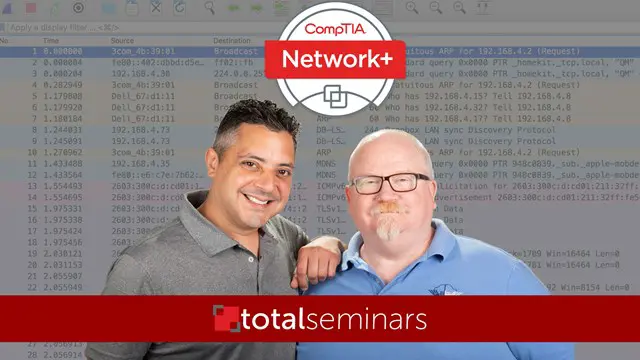
TOTAL: CompTIA Network+ (N10-008)
Everything you need to pass the CompTIA Network+ Exam (N10-008) from Mike Meyers and Joe Ramm!
Total Seminars, LLC
Summary
- Reed Courses Certificate of Completion - Free
Overview
What you'll learn
-
You will learn the knowledge and gain the confidence to pass the CompTIA Network+ Certification (N10-008) exam AND the skills to be a great network tech.
-
Your new skills and the CompTIA Network+ Certification will help you land a network tech job or get that raise or advancement you are seeking.
-
This course is ideal as both a study tool and an on-the-job reference.
-
Learn new networking skills and prepare for the CompTIA exam.
Curriculum
-
Course Introduction 08:37
-
Chapter 1: Network Models 50:33
-
Chapter 2: Cabling and Topology 40:37
-
Chapter 3: Ethernet Basics 47:00
-
Chapter 4: Ethernet Standards 37:52
-
Chapter 5: Installing a Physical Network 1:05:11
-
Chapter 6: TCP/IP Basics 1:36:44
-
Chapter 7: Routing 1:59:46
-
Chapter 8: TCP/IP Applications 1:59:26
-
Chapter 9: Network Naming 1:11:08
-
Chapter 10: Securing TCP/IP 1:27:00
-
Chapter 11: Switch Features 1:53:25
-
Chapter 12: IPv6 50:44
-
Chapter 13: WAN Connectivity 58:04
-
Chapter 14: Wireless Networking 1:48:46
-
Chapter 15: Virtualization and Cloud Computing 1:08:15
-
Chapter 16: Datacenters 1:05:33
-
Chapter 17: Integrating Network Devices 37:45
-
Chapter 18: Network Operations 1:33:24
-
Chapter 19: Protecting Networks 2:19:32
-
Chapter 20: Network Monitoring 53:14
-
Chapter 21: Network Troubleshooting 10:59
Course media
Description
Welcome to the TOTAL: CompTIA Network+ Certification (N10-008) course from Mike Meyers, Joe Ramm, and Total Seminars.
Mike is a CompTIA expert and best-selling author with over 25 years of experience teaching and creating certification prep materials. He is the author of the #1 selling CompTIA Network+ Certification All-in-One Exam Guide. Mike has sold over 1 million CompTIA certification prep books. Joe is an enthusiastic instructor with over 20 years of experience teaching and a master's degree in Instructional Design.
This course is over 21 hours in length and covers everything you need to know to pass your CompTIA Network+ Certification (N10-008) Exam. The first goal of the course is to make you a good Network Tech and, in the process, make sure you are ready to pass the CompTIA exam.
You'll love Mike and Joe's fun and engaging style as they walk you through all the Network+ topics. This is not a boring voice-over-PowerPoint lecture. Mike and Joe use props and illustrations to make learning fun!
Who is this course for?
- This course is intended for anyone that is preparing for a network technician position or looking to improve their skills and become CompTIA Network+ Certified. However, it goes beyond that and will give you the skills you need to be a better network tech on the job.
- This is a complete and comprehensive CompTIA Network+ Certification (N10-008) course. It is designed to prepare the student to be able to take and pass the certification exam needed to become CompTIA Network+ Certified.
Requirements
-
Basic familiarity with networks.
-
There are no specific prerequisites as the course covers all the topics in detail. However, it’s a good idea to have an understanding of CompTIA A+ Certification topics or to be A+ Certified. You can learn more about A+ Certification topics from our Mike Meyers – Total Seminars CompTIA A+ Certification course on Udemy.
Questions and answers
Currently there are no Q&As for this course. Be the first to ask a question.
Certificates
Reed Courses Certificate of Completion
Digital certificate - Included
Will be downloadable when all lectures have been completed.
Reviews
Currently there are no reviews for this course. Be the first to leave a review.
Legal information
This course is advertised on reed.co.uk by the Course Provider, whose terms and conditions apply. Purchases are made directly from the Course Provider, and as such, content and materials are supplied by the Course Provider directly. Reed is acting as agent and not reseller in relation to this course. Reed's only responsibility is to facilitate your payment for the course. It is your responsibility to review and agree to the Course Provider's terms and conditions and satisfy yourself as to the suitability of the course you intend to purchase. Reed will not have any responsibility for the content of the course and/or associated materials.


